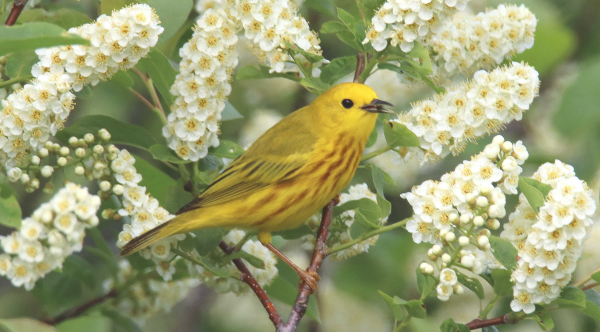
After a good photo episode at the biggest wild plum thicket a week before, the plum blooms were fading fast and drying – but the chokecherry blooms were opening. So with a partly cloudy sky and high hopes, I returned to the tangle of plums, but this time it was to position my mobile blind next to one of the adjoining stands of chokecherry bushes, which I found in full bloom at this a beautiful oasis on the open prairie. What birds would be hunting insects, caterpillars, and spiders here?
I mostly knew what to expect – Yellow Warblers – but I also hoped some of the Orchard Orioles would switch to the chokecherry flowers. The few Orchards I saw were still focused on the fading plum flowers. Even so, I knew this broad, tall stand of chokecherries was a favorite Yellow Warbler hangout; and that’s exactly what I spent most of my late afternoon-early evening photographing among the long luscious chokecherry blooms.
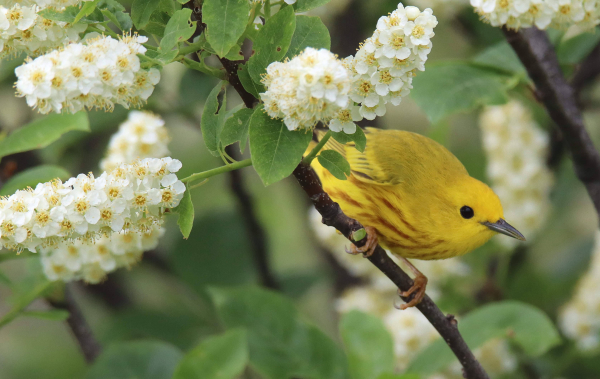
Yellow Warblers are among the most widespread and common nesting warblers across much of the continental United States and southern Canada – although their nesting range stretches from northern Alaska to southern Mexico. These little dynamos are dramatically colored with a beautiful bright golden yellow that catches everyone’s eyes, just as their sweet songs catch the attention of our ears. A closer inspection of the males shows reddish lines of color highlighting their belly and flanks, and the females’ slightly subdued yellow and richer olive coloration provides a beautiful variation when more than one Yellow Warbler is present.
Fast Action
Photographing Yellow Warblers among the abundance of chokecherry blooms was such a pleasing endeavor, a continuation of the songbird photography that I have been immersed in for more than a month. Mostly, it’s a matter of following the birds through the leaves and branches and flowers through the camera’s viewfinder, touching the shutter button to autofocus as one of the small yellow birds appears where it might break into the open for a photo, zooming in and out as necessary to keep an abundance of flowers in the frame – it’s all fast paced and fun! Then you hold your breath as you press the shutter button as the bird pausing a moment, maybe.
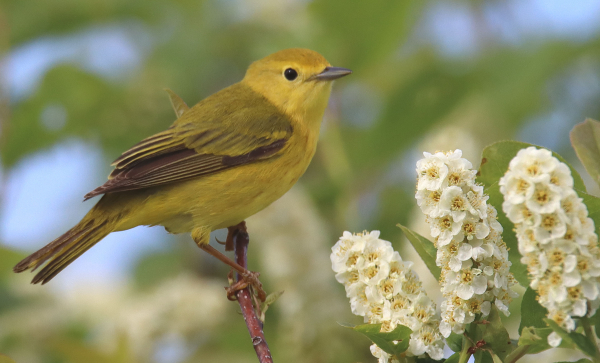
Then you are left with the chokecherry blooms, catching your breath, releasing the tension in your hands and arms, shoulders and back, yet watching intently for the next motion of yellow, or just the trembling of a branch to show a bird’s activity deeper within the chokecherry stand. There’s a little lull in the action, and then it’s on again as a female appears low in the foliage, working her way into the open as you focus on her and follow her foraging movements, trying to anticipate her next move. Fun! Exciting! Rewarding! Who could ask for more?
Overall, these open country Yellow Warblers were a bit more wary and a bit sneakier than the birds I’ve been photographing at Melody’s Grove. This was especially true for the females, which appeared to be fewer in number, and they were especially hard to photograph in the open, preferring to stay among the lower branches. It may be that this was a result of the territorial males foraging and singing from higher branches harried the females during this pre-nesting period, or perhaps some females were already incubating, hence I was seeing fewer of them.
Making Tiny Bigger
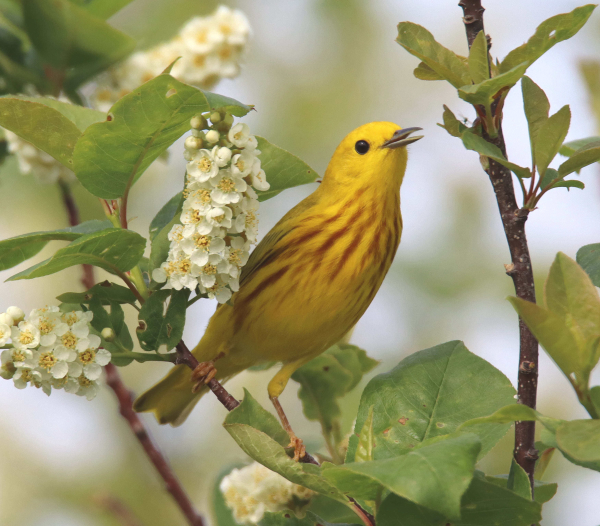
As this warbler illustrates, there’s always time to sing as you forage through an undergrowth of new flowers and leaves. In this photo the warbler is shaded below, but the brighter lighting on its upper half highlights the bird, its singing behavior, and the surrounding blooms (f6, 1/1250, ISO 400).
|
Sometimes when we look at the photos of warblers and even Orchard Orioles, we forget about how tiny these birds really are. They look big in most of the accompanying images, but in the field, they are really small, so it’s important for us to get close enough as they do their thing at a given location. Of course, we can rely on our telephoto or zoom lens to magnify the little dynamos, plus we can enlarge them a bit more in our digital darkrooms by simply cropping the background using our photo editing software. While cropping, it’s important to use your artistic talents to crop in just the right places to include key flower blossoms surrounding the golden warblers. Photography is an artform, photographing birds among beautiful bouquets of flowers can be even more artful.
Also, take a second look at the flowers to zero in on the detail on the blooms that are in tight focus. Notice the level of detail of the white petals and especially the yellow inner portion of each flower, that shows the stamens poking up in a circle around the stigma. Then check out the detail on the birds too. Sometimes it’s worth reminding ourselves just how remarkable the quality of photos is that we can take with the digital equipment we use today. The detail can be down to a near-microscopic level, and the resulting photos certainly reveal things we don’t notice or can’t see in the field.
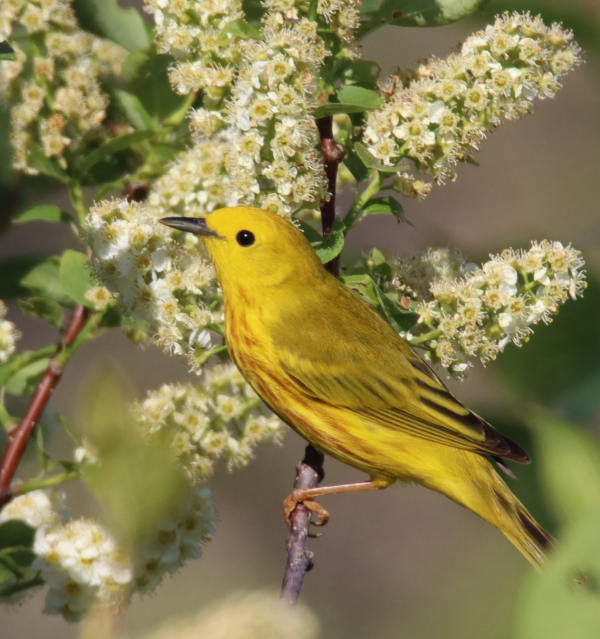
Fully illuminated in bright sunlight, the color and sharp features of this male Yellow Warbler overshadow the now fading flowers (f7, 1/1600, ISO 400).
|
Taking a closer look at the flowers also provides a pretty good indication of the area in focus using a given aperture setting (f-stop). The narrowest focal area that I can use with my zoom lens is f5, and when photographing songbirds I especially like to keep a narrow focus area to blur background vegetation out of focus. However, with the chokecherry blooms played such an important part of these photos, I tried to use a little wider focal area to keep more of the flowers in focus along with the warblers – usually an f7.
As the spring season comes to a close, with the first day of summer less than a week ahead, there will be new photo opportunities to take advantage of, new birds to draw our attention. That’s what makes birding so much fun, and it makes birding with a camera extra exciting. Then too, summer is a time we all like to venture beyond our local haunts to explore new areas with different photo potential. Good Luck as we enter this transition period on the June calendar, slipping from spring into summer. It’s going to be an exciting summertime I’m sure!
Article and photographs by Paul Konrad
Share your bird photos and birding experiences at editorstbw2@gmail.com
